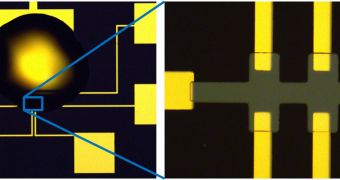Manufacturing technologies have become so small that, in order to improve semiconductors in a fundamental manner, it takes a breakthrough at atomic levels, as the one that IBM has just revealed.
The short version of the story is that IBM has achieved a materials science breakthrough at the atomic level that opens doors for extremely low-power non-volatile memory and logic chips.
That is to say it is possible to make an alternative to NAND Flash chips (used in SSDs, memory cards and flash drives), one much more power-efficient than those things already are. The same goes for logic chips.
The longer version of the story involves ionic currents and the mimicry of how the human brain operates.
Basically, IBM scientists looked at how the brain works and came up with a way that uses tiny ionic currents, which are streams of charged atoms, to reversibly transform metal oxides between insulating and conductive states.
By inserting and removing oxygen ions driven by electric fields at oxide-liquid interfaces, they transform innately insulating oxides into conductive ones.
This provides the materials with a stable metallic state even when power is cut, meaning that chips using this new phenomenon can be used to store and transport data in a more efficient, “event-driven” manner.
It is a distinct difference compared to how, today, computer semiconductors are made with CMOS process technologies (which are nearing physical and performance limitations).
“Our ability to understand and control matter at atomic scale dimensions allows us to engineer new materials and devices that operate on entirely different principles than the silicon based information technologies of today,” said Dr. Stuart Parkin, an IBM fellow at IBM Research.
“Going beyond today’s charge-based devices to those that use minuscule ionic currents to reversibly control the state of matter has the potential for new types of mobile devices. Using these devices and concepts in novel three-dimensional architectures could prevent the information technology industry from hitting a technology brick wall.”
IBM achieved the breakthrough by applying a positively charged ionic liquid electrolyte to an insulating oxide material (vanadium dioxide). The material maintained its metallic state until a negatively charged ionic liquid electrolyte was applied.

 14 DAY TRIAL //
14 DAY TRIAL //